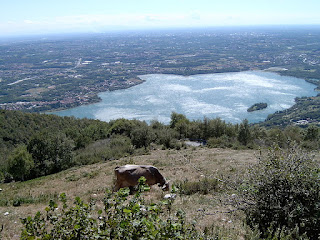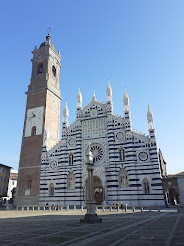Co-founder of iconic clothing and accessories brand
.jpg) |
| Luciano Benetton, who turns 90 today, has been active in the business much of his life |
Along with his sister, Giuliana, and their brothers, Carlo and Gilberto, Luciano launched the Benetton Group in 1965, specialising at first in colourful knitwear. From its original store in Belluno, a town in the northern part of the Veneto region, opened in 1965, the group enjoyed a rapid expansion in the 1970s and 80s and at the peak of its success had as many as 6,000 outlets around the world.
Although it has faced tougher trading conditions in more recent years, the group continues to preside over more than 3,500 stores.
Since 1989, the Benetton empire has traded under the name United Colors of Benetton, a brand adopted as part of a long-running collaboration with photographer Oliviero Toscani, who masterminded the group’s provocative and often controversial advertising campaigns.
The Benetton story began in 1955 when Luciano, who had left school at age 14 to work in a clothing store after the death of his father, was working as a knitwear salesman. He had the idea to launch his own business, selling sweaters based on the colourful garments that his sister, Giuliana, designed and knitted for friends and family.
To raise the money needed to buy a knitting machine, he and Giuliana reportedly sold Luciano's accordion and a bicycle belonging to Carlo. Giuliana was responsible for making the sweaters, which Luciano sold to shops in and around Treviso, using his own bicycle to deliver them.
 |
| The subtext of much of Benetton's advertising has reflected the company's embrace of diversity |
The first Benetton shop was opened shortly afterwards, about 70km (43 miles) further north in the beautiful and prosperous town of Belluno in the Eastern Dolomites.
More outlets were opened in Italy and in 1969 Benetton ventured outside their home country to open a store in Paris. By the early 1970s, the company had a network of 200 shops around Europe.
The business steadily grew throughout the decade, expanding its range beyond simply sweaters. In 1974, the French fashion company, Sisley, became part of the Benetton Group.
The first Benetton store in New York opened in 1980, followed by a store in Tokyo in 1982. By the mid-1980s, a Benetton store was opening almost daily. This decade, and the early ‘90s, saw the business at its peak.
 |
| United Colors of Benetton was adopted as the company's brand name from the late 1980s |
Luciano wanted his advertising to reflect the company’s values, namely having a social conscience and being advocates of tolerance and diversity, but much of it was designed to shock, particularly after Toscani became involved. Billboard images such as those showing a duck drenched with crude oil, a naked man with “HIV Positive” branded on his buttock, and an unwashed new-born baby with umbilical cord still attached, all labelled with United Colors of Benetton, became the company’s stock in trade.
The campaigns prompted a number of lawsuits in different countries but at the same time ensured the Benetton brand remained in the public eye.
Luciano also identified sports sponsorship as a way to consolidate public awareness of the company name. After first sponsoring Treviso’s rugby team, AS Rugby Treviso, which became a major force in Italian rugby, Benetton became an even bigger influence in motor racing.
 |
| Benetton took their colourful image into the world of Formula One racing with considerable success |
As the clothing market became more challenging, Benetton’s success began to wane in the 2000s and Luciano and the other family members stepped back from management roles, although Luciano would twice return to the boardroom out of concern for the company’s ailing fortunes, resigning from his latest stint only in 2024, at the age of 89.
Away from business, Luciano Benetton served as a senator for the Italian Republican Party from 1992 to 1994, while his Fondazione Benetton Studi Ricerche has developed the Imago Mundi Collection, a vast collection of contemporary art.
In Treviso, where he still lives, his Gallerie delle Prigioni - so called because it is housed in an historic prison from the Habsburg era - provides an exhibition space dedicated to contemporary culture.
 |
| Piazza dei Signori is the beautiful square at the centre of the city of Treviso |
For many visitors to Italy, Benetton’s home town of Treviso in the Veneto is no more than the name of the airport at which they might land en route to Venice, yet it is an attractive, historic city worth visiting in its own right, rebuilt and faithfully restored after the damage suffered in two world wars. Canals are a feature of the urban landscape – not on the scale of Venice but significant nonetheless – and the Sile river blesses the city with another stretch of attractive waterway, lined with weeping willows. The arcaded streets fanning out from the central square, Piazza dei Signori, have an air of refinement and prosperity and there are plenty of restaurants, as well as bars serving prosecco from a number of vineyards. The prime growing area for prosecco grapes in Valdobbiadene is only 40km (25 miles) away to the northeast. Treviso also claims to be the birthplace of the famous Italian dessert, tiramisu.
.jfif) |
| Benetton's headquarters remains the Villa Minelli in Ponzano Veneto, which the family bought in 1968 |
The Benetton Group headquarters is located in Villa Minelli, in Via Villa Minelli in Ponzano Veneto. It is a building complex built in the 17th century by a family of merchants, which includes a central villa, two colonnades and a small church. After the Minelli family, the villa was abandoned for over 150 years until the Benetton family purchased it in 1968. The renovation project was granted to Afra and Tobia Scarpa, the same architects responsible for the construction of the company’s first factory, the Maglierie Benetton, also in Ponzano Veneto. The renovation took over 15 years to complete. The architects won praise for preserving the solemnity of the villa while also transforming it into an efficient working place, with offices and meeting rooms. The villa is surrounded by vineyards and the park.
Also on this day:
1726: The death of singer and composer Francesco Pistocchi
1804: The birth of Venetian revolutionary leader Daniele Manin
1909: The first Giro d’Italia cycle race
1938: The birth of politician Giuliano Amato
.jpg)

.jpg)



































